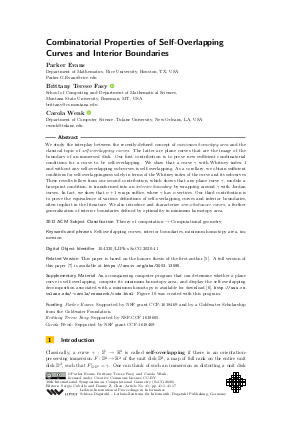Combinatorial Properties of Self-Overlapping Curves and Interior Boundaries
Authors
Parker Evans,
Brittany Terese Fasy  ,
Carola Wenk
,
Carola Wenk 
-
Part of:
Volume:
36th International Symposium on Computational Geometry (SoCG 2020)
Part of: Series: Leibniz International Proceedings in Informatics (LIPIcs)
Part of: Conference: Symposium on Computational Geometry (SoCG) - License:
 Creative Commons Attribution 3.0 Unported license
Creative Commons Attribution 3.0 Unported license
- Publication Date: 2020-06-08
File

PDF
LIPIcs.SoCG.2020.41.pdf
- Filesize: 1.14 MB
- 17 pages
Document Identifiers
Related Versions
-
This paper is based on the honors thesis of the first author [Parker Evans, 2018]. A full version of this paper [Parker Evans and Carola Wenk, 2020] is available at https://arxiv.org/abs/2003.13595.
Subject Classification
ACM Subject Classification
- Theory of computation → Computational geometry
Keywords
- Self-overlapping curves
- interior boundaries
- minimum homotopy area
- immersion
Metrics
- Access Statistics
-
Total Accesses (updated on a weekly basis)
0Document
0Metadata
Abstract
We study the interplay between the recently-defined concept of minimum homotopy area and the classical topic of self-overlapping curves. The latter are plane curves that are the image of the boundary of an immersed disk. Our first contribution is to prove new sufficient combinatorial conditions for a curve to be self-overlapping. We show that a curve γ with Whitney index 1 and without any self-overlapping subcurves is self-overlapping. As a corollary, we obtain sufficient conditions for self-overlapping ness solely in terms of the Whitney index of the curve and its subcurves. These results follow from our second contribution, which shows that any plane curve γ, modulo a basepoint condition, is transformed into an interior boundary by wrapping around γ with Jordan curves. In fact, we show that n+1 wraps suffice, where γ has n vertices. Our third contribution is to prove the equivalence of various definitions of self-overlapping curves and interior boundaries, often implicit in the literature. We also introduce and characterize zero-obstinance curves, a further generalization of interior boundaries defined by optimality in minimum homotopy area.
Cite As Get BibTex
Parker Evans, Brittany Terese Fasy, and Carola Wenk. Combinatorial Properties of Self-Overlapping Curves and Interior Boundaries. In 36th International Symposium on Computational Geometry (SoCG 2020). Leibniz International Proceedings in Informatics (LIPIcs), Volume 164, pp. 41:1-41:17, Schloss Dagstuhl – Leibniz-Zentrum für Informatik (2020)
https://doi.org/10.4230/LIPIcs.SoCG.2020.41
BibTex
@InProceedings{evans_et_al:LIPIcs.SoCG.2020.41,
author = {Evans, Parker and Fasy, Brittany Terese and Wenk, Carola},
title = {{Combinatorial Properties of Self-Overlapping Curves and Interior Boundaries}},
booktitle = {36th International Symposium on Computational Geometry (SoCG 2020)},
pages = {41:1--41:17},
series = {Leibniz International Proceedings in Informatics (LIPIcs)},
ISBN = {978-3-95977-143-6},
ISSN = {1868-8969},
year = {2020},
volume = {164},
editor = {Cabello, Sergio and Chen, Danny Z.},
publisher = {Schloss Dagstuhl -- Leibniz-Zentrum f{\"u}r Informatik},
address = {Dagstuhl, Germany},
URL = {https://drops.dagstuhl.de/entities/document/10.4230/LIPIcs.SoCG.2020.41},
URN = {urn:nbn:de:0030-drops-121993},
doi = {10.4230/LIPIcs.SoCG.2020.41},
annote = {Keywords: Self-overlapping curves, interior boundaries, minimum homotopy area, immersion}
}
Author Details
- School of Computing and Department of Mathematical Sciences, Montana State University, Bozeman, MT, USA
Funding
- Evans, Parker: Supported by NSF grant CCF-1618469 and by a Goldwater Scholarship from the Goldwater Foundation.
- Fasy, Brittany Terese: Supported by NSF-CCF 1618605.
- Wenk, Carola: Supported by NSF grant CCF-1618469.
Supplementary Materials
- An accompanying computer program that can determine whether a plane curve is self-overlapping, compute its minimum homotopy area, and display the self-overlapping decomposition associated with a minimum homotopy is available for download [Parker Evans et al., 2016], http://www.cs.tulane.edu/~carola/research/code.html. Figure 10 was created with this program.
References
-
Samuel J. Blank. Extending Immersions of the Circle. PhD thesis, Brandeis University, 1967.

-
Erin Chambers and David Letscher. On the height of a homotopy. In 21st Canadian Conference on Computational Geometry, pages 103-106, 2009.

-
Erin Chambers and Yusu Wang. Measuring similarity between curves on 2-manifolds via homotopy area. In Proc. Proc. 29th Symposium on Computational Geometry, pages 425-434, 2013.

-
David Eppstein and Elena Mumford. Self-overlapping curves revisited. SODA '09 Proceedings of the twentieth annual ACM-SIAM Symposium on Discrete Algorithms, 2009.

-
Parker Evans. On self-overlapping curves, interior boundaries, and minimum area homotopies. Undergraduate Thesis, Tulane University, 2018.

- Parker Evans, Andrea Burns, and Carola Wenk. Homotopy visualizer. http://www.cs.tulane.edu/~carola/research/code.html, 2016. URL: http://www.cs.tulane.edu/~carola/research/code.html.
- Parker Evans and Carola Wenk. Combinatorial properties of self-overlapping curves and interior boundaries, 2020. URL: http://arxiv.org/abs/2003.13595.
- Brittany Terese Fasy, Selcuk Karakoc, and Carola Wenk. On minimum area homotopies of normal curves in the plane, 2017. URL: http://arxiv.org/abs/1707.02251.
-
Carl Friedrich Gauß. Zur Geometria Situs. In Nachlass. I. Teubner-Archiv zur Mathematik, ca. 1900.

-
Jack Graver and Gerald Cargo. When does a curve bound a distorted disk? SIAM Journal on Discrete Mathematics, 25(1):280-305, 2011.

-
Selcuk Karakoc. On Minimum Homotopy Areas. PhD thesis, Tulane University, 2017.

-
Morris Marx. The branch point structure of extensions of interior boundaries. Transactions of the American Mathematical Society, 131(1):79-98, 1968.

-
Morris Marx. Extending immersions of 𝕊^1 to ℝ². Transactions of the American Mathematical Society, 187:309-326, 1974.

-
Uddipan Mukherjee. Self-overlapping curves: Analaysis and applications. 2013 SIAM Conference on Geometric and Physical Modeling, 2013.

-
Uddipan Mukherjee, M. Gopi, and Jarek Rossignac. Immersion and embedding of self-crossing loops. Proc. ACM/Eurographics Symposium on Sketch-Based Interfaces and Modeling, pages 31-38, 2011.

-
Herbert Seifert. Konstruktion dreidimensionaler geschlossener Raume. PhD thesis, Saxon Academy of Sciences Leipzig, 1931.

-
Peter W. Shor and Christopher Van Wyk. Detecting and decomposing self-overlapping curves. Computational Geometry: Theory and Applications, 2(1):31-50, 1992.

-
Charles Titus. A theory of normal curves and some applications. Pacific J. Math, 10(3):1083-1096, 1960.

-
Charles Titus. The combinatorial topology of analytic functions of the boundary of a disk. Acta Mathematica, 106(1):45-64, 1961.

-
Hassler Whitney. On regular closed curves in the plane. Compositio Math. 4, pages 276-284, 1937.

